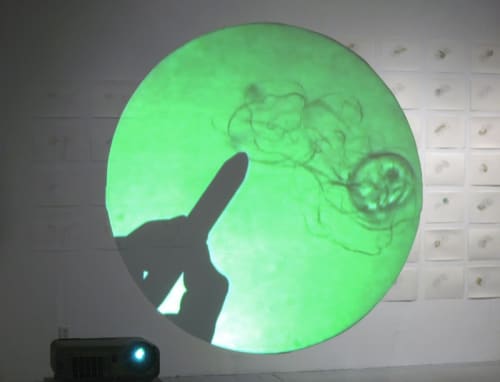"I saw a multitude of small living animals moving, more than a thousand, whose size was equal to that of a grain of sand (...) these small animals were the most miserable creatures that I ever saw …" Anthony Van Leeuwenhoek, 1676.
Pierre François Ouellette Art contemporain is pleased to present Apprivoisements fugaces (Fleeting Mastery), an exhibition of recent works by Annie Thibault. Since 1995, Annie Thibault has worked on a of living laboratory project entitled the The Room of Cultures (La chambre des cultures). Centered on scientific thought and the origin of life, this project explores the possible intersections between art and biology through multidisciplinary installations and the handling of living cells. Over the years, these laboratories became her itinerant workshops where as a "research- artist", she explores and questions the many systems and networks of growth of the first living beings. The new exhibition at the gallery, Apprivoisements fugaces (Fleeting Mastery), follows Méandres, a group exhibition curated by Nicole Gingras, produced by DAïMON and presented jointly with AXE NÉO-7 last Fall in Gatineau. In the catalogue accompanying Méandres, Nicole Gingras states:
"Fascinated by the mobility of microscopic organisms, Annie Thibault pursues her exploration of the infinitely small. In this work, she picks up the movements of these organic forms with the help of a light device that also serves as a drawing table, enabling her to create an overhead projection of video excerpts in which she isolates elements of several drawings. The paper she traces on plays the role of a screen and support for the drawing. She painstakingly observes these microscopic organisms, adjusting and reacting to their movements. Patiently, she traces their movements, pencil in hand, and films herself drawing. A strange shadowing. Annie Thibault seems to want to slow down the movement of the phenomena she observes. A singular dialogue between her anticipation of the microscopic form’s movement and the movement she is trying to master ensues. Her drawings reveal strange choreographies made up of loops, doubling backs, breaks and quiverings. She remarks that "in creating a dialogue between the drawing and the video, I’m trying to capture the essence of a fleeting image, thereby creating a waltz between the line drawn by my hand and the fleetingness of the microscopic specimens’ movements"". 1
In this curious dialogue, Annie Thibault follows in the same spirit of research and intuitive approach of the first microbiologists of the 17th century whose scientific observations were made with the only means available to them: drawing from observation. The artist, however, has the advantage of a light table that enables her to draw directly onto the projected images of plankton. "I have the impression of entering into an intimate relationship with the specimens - observed without passing through the technological eye of the microscope. The act of drawing takes on its full meaning here as an agent of revelation. Fleeting Mastery reveals my own interest in understanding the ceaseless transition between force and fragility in the living, while exploring the complex and ambiguous relationship that it shares with the human being that supports it.”
Annie Thibault lives and works in Gatineau. She works primarily in drawing and has gradually been incorporating sculpture, installation and video into an aesthetic of encounters between art, science and nature. Since 1995, she has designed and produced “La chambre des cultures,” an ongoing laboratory project carried out through residencies and exhibitions in Canada and abroad, in particular at the Musée national des beaux-arts du Québec in 2002, the Metrònom gallery of the Fundaciò d’art contemporani Rafael Tous in Barcelona in 2004 and at the National Gallery of Canada in 2007.
Annie Thibault would like to thank the biologist Danièle Raby for the Baie de Gaspé marine plankton sample and images. The images of freshwater plankton were created by the artist in the biology laboratories of the Université de Montréal. Special thanks also to DAÏMÕN, Nicole Gingras, François Bélanger and the Conseil des arts et des lettres du Québec and the Canada Council for the Arts.
